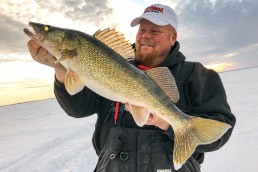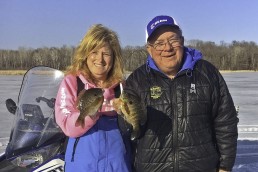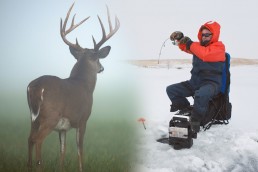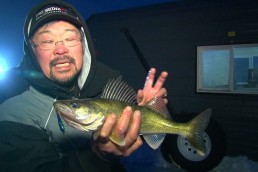March, the best Ice-Fishing Month
SHARE THIS POST
March is the best month of the winter for ice-fishing in most of the Ice Belt, but anglers are never sure how the ice conditions will impact access to the lakes. Some years the ice starts to break down fast, while other years the ice-fishing season in some areas extends all the way into early April.
In my home state of Minnesota, anglers need to go to one of the border waters or travel to a neighboring state or Canada to continue fishing for walleyes and other gamefish during March. The season closes in February for walleyes and other gamefish in Minnesota, so anglers are limited to what species they can pursue unless they go on a road trip.
The ice conditions and the closed seasons make March the best part of the winter to travel and try new areas. If anglers want to stay closer to home, they can be very happy fishing good bites for species like perch, crappies, sunfish and even trout, eelpout and whitefish.
New waters to hit
There are many areas outside of Minnesota on my list of areas I want to fish during March. I like to go somewhere new each year, so I can keep checking boxes on my list and keep learning new areas and adding more lakes to my personal inventory of lakes when my guiding schedule and the ice conditions allow me to do so.
Devils Lake is one of my favorite lakes both in summer and during the winter. So, it always gets consideration from me during March. It is an easy drive from my home and a super productive lake for late-season walleyes and perch.
There are also other good lakes in North and South Dakota worth consideration for my March trip, which are all relatively close to home for me and take less time to visit when my “free time” gets scarce.
I can also fish Lake of the Woods and Rainy Lake, which are both Border Lakes with extended seasons for walleyes that are close enough to my home that they are possible day trip destinations if I only have a day or two opening in my busy schedule.
Anglers are reminded the walleye limit on Lake of the Woods changes to an aggregate limit of 6 walleyes and sauger, with no more than 4 walleyes allowed in a limit on March 1, 2019. There is also a protected slot limit for walleyes between 191/2 and 28 inches in Lake of the Woods.
Spring on the Rainy River
The Spring Walleye Season on the Rainy River also changes this year. The old limit of 2 walleyes under 19.5 inches has been changed, with the spring season now “catch and release” only. It will be interesting to see how much this changes the fishing pressure on the Rainy River for the spring season.
Lake Superior is another possible destination during March, depending on the ice conditions. During some years, there is enough ice for ice fishing close to shore during March, while in other years it is open water.
Anglers fishing Lake Superior are able to catch lake trout, Chinook salmon and lake herring as the most commonly caught species, although there are other species that infrequently show up on anglers lines during the winter season.
Are you enjoying this post?
You can be among the first to get the latest info on where to go, what to use and how to use it!
I used to throw back lake herring until I got chewed out by one of my buddies. Now that I have tried eating fresh pan-fried herring, I don’t throw them back anymore.
I have other desirable destinations in mind for March in other states in Canada that I would like to check out at some point when time allows. I look forward to March every year and hope to expand my ice-fishing experiences even further during my favorite month of the year for ice fishing across the ice belt.
One thing is a constant whenever fishing a new lake or when fishing new areas through the ice. A good lakemap is critical—whether it is a paper map to look at night for ideas and planning, or an accurate mapchip that I can use in my Humminbird Helix Ice7—to help me navigate and break down the lakes the way I need to do in order to catch fish.
It is hard to imagine being successful during the limited time period I would have when fishing a new lake in an unfamiliar part of the country without the aid of an accurate mapchip and lakemap. I really wouldn’t even want to try it because of my own personal expectations of a good time on the ice.
Head for the shallows
When I am guiding during March, the main species I go after with my clients are perch and crappies. Each year is different with perch, with a portion of the population using deep structure and a portion of the population using shallow cover. The general direction of movement of perch during March is towards shallow water, so it is all about the timing.
The first meltdown of the snow causes fresh water to flow into the lakes, which is what helps rejuvenate the shallows and allows the fish using deep water to move back into the shallows.
I always prefer to fish shallow water whenever possible, so my clients can release fish successfully. When the fish are located in deep water, there is no safe way to release fish in deep water because they get barotrauma and have difficulty getting back to the bottom.
I can qualify many areas in deep water without fishing by using my AquaVu HD7 to clearly see what species and what size of fish I am dealing with, which speeds up the process and is very helpful to me in my winter guiding.
Crappies also move towards shallow water on late ice, leaving the basin areas to head closer to their spawning sites, where they will alternately feed and rest until they are ready to spawn later in May or early June.
Eelpout and whitefish are also cool species I like to catch in March. My wife Heather loves eelpout, so we like to go after them and have at least one meal of eelpout each March.
Many anglers on the Great Lakes target whitefish during the winter. In Minnesota, whitefish are not as plentiful, but the fish that average a couple of pounds in most areas can hit double digits in Minnesota and have trouble fitting up a six inch hole.
MWO
SHARE THIS POST
Did you enjoy this post?
You can be among the first to get the latest info on where to go, what to use and how to use it!
Brian 'Bro' Brosdahl
Outdoor communicator Brian “Bro” Brosdahl lives in northern Minnesota. He is a walleye guide in the Cass Lake, Leech Lake and Lake Winnibigoshish areas. He is sponsored by Northland Fishing Tackle, Frabill/Plano, Aqua-Vu, Humminbird/Minn Kota, St. Croix Rods, Ranger Boats, and Evinrude. Guide inquiries: brosguideservice.com. Follow on social media.



